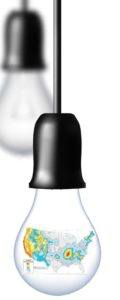When my partner, Vivek Basrur, and I started Karen Clark & Co. (KCC), we had no intention of building catastrophe models again. In fact, that’s the one thing we said we wouldn’t do.
Executive Summary
Without ever having made a conscious decision to build catastrophe models again, modeling pioneers Karen Clark and Vivek Basrur wound up doing just that at Karen Clark & Co. Here, Clark describes the driving force that is one of the necessary ingredients of innovation: a growing and irrepressible passion. Other factors that drive innovation forward at KCC are a guiding vision, a small and nimble team to implement it, and a totally immersed leader making sure an otherwise messy innovation process stays on plan.But after a few years of working with dozens of insurers and reinsurers as independent expert consultants, we discovered there were important market needs not being addressed by the existing vendor models. For one thing, the model-generated loss estimates were not providing enough intuitive and operational information for CEOs and senior management. The volatility in loss estimates from model update to update posed challenges for underwriters, and model users had to develop resource-intensive processes around the models in order to understand what was inside.
In many instances, we found low confidence in the model-generated loss estimates, and we heard on too many occasions: “We don’t believe the numbers, but it’s the only tool we have, so we have to use it.”
That just didn’t seem right, so we decided to build new tools and eventually reinvent the models. As is probably the case with most innovations, it wasn’t really a conscious decision but rather a growing and ultimately irrepressible passion. The more people said it couldn’t be done, the more determined we became to do it.
The Guiding Vision
Innovation is a complex and messy process—and definitely not for the faint-hearted. As my partner likes to say, “It’s like building the plane while flying it.”
 You have to be a little crazy and believe you can do something without knowing exactly how you’re going to do it.
You have to be a little crazy and believe you can do something without knowing exactly how you’re going to do it.
In our case, we determined that the fundamental issue with the first-generation cat models is they are closed “black boxes.” This is the root of most user problems. It’s difficult to fully understand or have confidence in numbers when you don’t know exactly what’s driving those numbers.
Our guiding vision has been that because the models are being used for important financial decisions, they must be open. Because there’s so much uncertainty around model assumptions, insurers must have full visibility on, and control over, those assumptions.
The fundamental value of a catastrophe model is the structured approach to loss estimation, using an event catalog, intensity module, damage functions and a financial module. Why couldn’t we build all of these same components but make them fully transparent to the user? Furthermore, we could empower insurers to customize the model assumptions to be more reflective of their own claims experience, thereby producing more reliable and accurate loss estimates.
Implementing the Vision
When we embarked on implementing this vision, most thought it an impossible undertaking. The older models were too entrenched and the barriers too high, according to the many naysayers.
 While we knew it was going to be a monumental task, KCC has significant competitive advantage in this space. Most importantly, we have the expertise and knowledge of a cat modeling company, and we had a clean slate to work with. With no legacy software or status quo to protect, we knew we could develop a better product. We could start from scratch and design an open loss modeling platform built for today’s needs and model users.
While we knew it was going to be a monumental task, KCC has significant competitive advantage in this space. Most importantly, we have the expertise and knowledge of a cat modeling company, and we had a clean slate to work with. With no legacy software or status quo to protect, we knew we could develop a better product. We could start from scratch and design an open loss modeling platform built for today’s needs and model users.
The ability to take a totally fresh look at the models from the perspective of the users is the key to real innovation in cat modeling technology. People sometimes ask why the traditional model vendors aren’t doing what KCC is doing, and the reason is they have little incentive to change the value proposition of the models and disrupt the status quo. Disruptive innovation is obviously more likely from new market entrants than from established players.
While it may seem counterintuitive, having a smaller team than the larger vendors is also a significant advantage. Successful implementation of an ambitious vision requires continuous monitoring, prioritization and adjustment. The KCC model and software developers operate as a cohesive and nimble team that can rapidly address any issues, make quick decisions and move forward.
Innovation is messy and doesn’t happen exactly according to plan. It’s my job to be totally immersed in the process so I know where we are at every point in time. There’s a constant need to make sure the entire team is focused on the current priorities, which can change frequently.
Ideas are easy; implementation is the hard part. People come to me all the time with new ideas, and my first question is, “Who is going to implement it?” The difficulties and challenges in actually implementing a vision are usually significantly underestimated, and this is where new initiatives typically falter and even fail.
If I have an advantage, it’s knowing what the KCC team can do and making sure we deliver on our promises to our clients. It’s being able to break a seemingly insurmountable task into logical pieces that we can tackle one by one to achieve the ultimate goal. We first built a solid foundation with our modeling platform, and now we deliver new features and functionality to our clients on a regular schedule.
Innovation in this space doesn’t require a lot of people, but it does require the right people. KCC professionals are not only smart and knowledgeable experts; they’re highly motivated by the KCC vision. Everyone is excited about what KCC is doing, which makes for a highly efficient, productive and fun team.
The Early Adopters
One of the most essential ingredients to successful innovation is the early adopters—those first 10-12 client companies that believe in the vision and are willing to go out on a limb to do something great.
At KCC, we’ve observed the innovation paradox: Everyone wants to innovate, but no one wants to be first.
The first question after a new product demonstration that has just wowed the audience is typically, “Who else is using it?” That’s why the early adopters are so important. The majority of insurers won’t adopt new technology until a critical number of companies are already using it.
Even if one sees clearly the rational benefits of advanced technology, there’s the fear of making a mistake. Most people don’t want to take a chance on something different if it might make them look bad—it’s much safer to stay with the crowd.
Of course, people don’t feel “fear,” per se, because they can come up with many reasons why it’s better not to change. Resistance to change is reinforced by “confirmation bias,” through which people naturally gravitate to the information that confirms decisions they’ve made previously.
So, motivating insurers to make a change takes persistence and appropriate messaging to let them know it’s highly beneficial—and, reading between the lines, safe—to advance to a new technology. As the number of early adopters grows, the new technology automatically becomes “safer.”
Early adopters are also important because they can spread the word and help build market momentum and penetration. KCC clients are excited about what they can do with the new open loss modeling technology and are happy to talk about it. And nothing motivates the KCC team more than happy clients who are successfully leveraging the new tools and capabilities to their advantage.
KCC’s success in innovation can be attributed to a number of factors. Most important are:
- An unwavering guiding vision that we’re passionate about—building advanced technology that provides more powerful capabilities and more accurate loss estimates for insurers.
- A nimble, efficient and highly motivated team that is able to implement the vision.
- A supportive group of early adopters.
And, of course, successful innovation is not possible without unrelenting determination and drive, thick skin, and a healthy dose of audaciousness. At KCC, that’s how we do it.





















 Despite Break in Car Prices, Soaring Insurance Costs Hit U.S. Buyers
Despite Break in Car Prices, Soaring Insurance Costs Hit U.S. Buyers  USAA to Lay Off 220 Employees
USAA to Lay Off 220 Employees  Triple-I: Insurance Economic Drivers Outperform Overall U.S. GDP
Triple-I: Insurance Economic Drivers Outperform Overall U.S. GDP  Travelers: Distracted Driving Incidents Continue to Rise
Travelers: Distracted Driving Incidents Continue to Rise 









